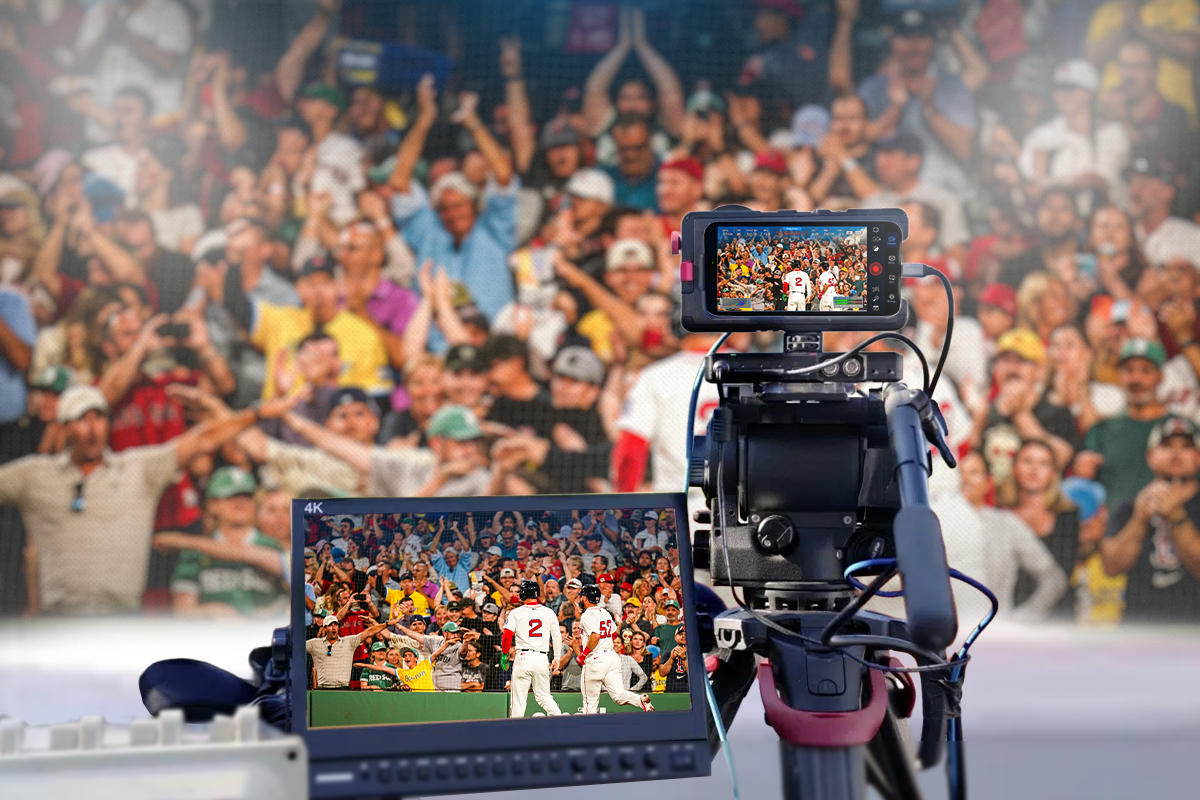

Sports broadcasting used to be an industrial machine: giant cameras that cost a fortune, trucks the size of houses, and armies of operators stitching replays and graphics together. Fans never saw the gear, only the polished feed on their TVs. And now, that entire setup is being challenged by something that fits in your pocket.
Watch What’s Trending Now!
On September 26, 2025, during ‘Friday Night Baseball’ at Fenway Park, Apple and MLB conducted a live experiment that turned traditional broadcasting on its head. For the first time in sports history, they used four iPhone 17 Pros as part of the Apple TV+ broadcast. The phones were positioned strategically: one inside the Green Monster, a couple in the dugouts, and one serving as a roaming unit. But these weren’t fan‑cam novelties. The phones captured batting practice, player intros, dugout energy, and the roar of the crowd, controlled remotely with the Blackmagic Camera app.
Exposure, zoom, and white balance were all tweaked live on iPads before the footage flowed straight into the broadcast truck. And when the “Shot on iPhone” badge flashed on Apple TV+, millions of fans realized they weren’t watching a commercial — they were watching a first.
ADVERTISEMENT
So why would Apple gamble its flagship device on the chaos of live baseball, where there are no retakes and no perfect lighting? Because this wasn’t just about baseball. It was about rewriting the rules of broadcasting.
Why this moment matters for Apple
Apple has hyped iPhone cameras before. Samsung had its “Shot on Galaxy” short films, Apple countered with its own campaigns, and even filmed a 2023 product launch entirely on iPhone 15 Pro Max. But those were controlled sets — rehearsed, lit, edited. Fenway was none of that. It was messy, live, and unforgiving. And that’s why it mattered.
ADVERTISEMENT
Apple proved that a device anyone can buy tomorrow could survive a national sports broadcast and blend seamlessly with professional $200,000-plus broadcast rigs. That’s not a flex. That’s a disruption. And it points to a much bigger target: the creator economy.
Apple knows the next broadcasters aren’t on ESPN….
ADVERTISEMENT
TikTok now has 1.59B users worldwide, with 135M in the U.S. alone.
Here’s why this shift is a game-changer:
Apple everywhere: Seamless ecosystem from capture to consumption. TikTokers and content creators can leverage the same tools as national broadcasters.
Lower costs, bigger creativity: iPhones reduce production costs, let teams capture angles traditional rigs can’t reach, and require smaller crews.
The Domino effect: If iPhones can handle MLB broadcasts, expect other leagues and sports to follow quickly.
ADVERTISEMENT
The hardware backs it up, too. The iPhone 17 Pro’s triple 48MP cameras, 24–200mm focal range, and 8x telephoto zoom give directors pro-level flexibility in a $1,099 package. And the payoff showed up immediately: launch-day iPhone 17 sales jumped 19% over the iPhone 16, with Wedbush now projecting 240–250M units this year — a record.
But the real story isn’t sales…
ADVERTISEMENT
The business strategy behind Live sports innovation
In March 2022, Apple made its inaugural foray into live sports broadcasting by securing a seven-year deal with MLB valued at $595M. This agreement granted Apple exclusive rights to broadcast Friday Night Baseball games on Apple TV+ starting in April 2022. Just a few months later, it doubled down with a $2.5B, 10-year MLS deal, giving fans every match with zero local blackouts.
Here’s why Apple jumped in:
- Content Experiments: Testing new ways to capture and deliver live games.
- Apple TV+ Expansion: Exclusive sports add value and attract subscribers.
- Ecosystem Synergy: iPhones and Vision Pro make sports immersive across devices.
- Services Growth: Subscription-based sports boost Apple’s booming services revenue.
- Brand Innovation: Reinforcing Apple as a leader in entertainment, not just tech.
When the iPhone 17 Pro made its live MLB debut, capturing Clayton Kershaw’s final regular-season start after months of secret tests, it blended into the broadcast as seamlessly as the $200,000 rigs surrounding it. The phones pumped broadcast‑ready frame rates, HDMI‑to‑SDI feeds, and integrated instantly into the production truck. And once you realize how cheap that setup was, the numbers tell a story networks can’t ignore.
Traditional sports cameras are serious money:
Pro broadcast camera: $50,000–$200,000
Crew position for a full season: $300,000–$500,000
Compare that to four iPhones with docks for a single game: under $10,000. A single iPhone 17 Pro runs about $1,099. And it’s more than savings. But the real advantage isn’t just cost, it’s flexibility. Directors can jump to an iPhone angle instantly, live‑tweak exposure or zoom, and let cameras run continuously without swapping operators. It’s the same spirit that fueled iPhone‑shot films like Tangerine, Unsane, and High Flying Bird, pushing creativity by shrinking the gear. Apple, now a $3 trillion giant, isn’t just flexing.
It’s testing whether consumer gear can upend decades of entrenched broadcast norms. The ripple is obvious: If leagues start leaning on Apple‑style hardware, do Sony, Canon, and the traditional camera giants face disruption? Or in sports terms, do they see the next pitch coming, or are they about to get caught looking?
ADVERTISEMENT
ADVERTISEMENT
ADVERTISEMENT

